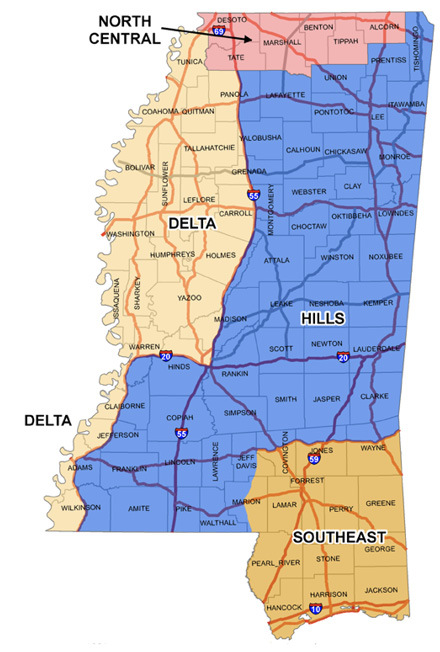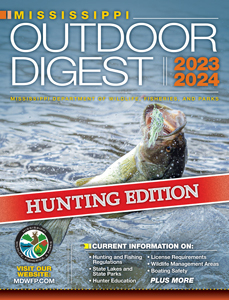White-Tailed Deer Hunting

Deer Management Unit (DMU) lines are based on soil regions using highways and interstates as dividing boundaries.
Deer Management Units
North Central: Private and open public lands in Alcorn, Benton, Desoto, Marshall, Tate, Tippah counties.
Hills: All areas except the Delta, North Central, and Southeast Deer Management Units. OPEN PUBLIC LANDS include National Forests, excluding the Holly Springs National Forest, Corps of Engineers lands, etc., that have statewide seasons without special regulations.
Southeast: Private and open public lands south of U.S. Highway 84 and east of MS Highway 35.
Delta: Private and open public lands west of I-55 and north of I-20 plus areas south of I-20 and west of U.S. Highway 61.
Bag Limits
Antlered Buck Deer
With the exception of the North Central DMU, the statewide bag limit on antlered buck deer is one (1) buck per day and three (3) per annual season. One (1) of these three (3) may have hardened antlers that do not meet the DMU legal antler requirements on private land and Holly Springs National Forest. Antlered buck bag limit in the North Central DMU is one (1) buck per day and four (4) per annual season. No antler restrictions apply to this DMU. All four bucks may have any sized hardened antlers. For youth hunters fifteen (15) years of age and younger, hunting on private land and authorized state and federal lands, all three (3) of the three (3) buck bag limit may be any antlered deer.
Antlerless Deer
Private Land: With the exception of the North Central and Southeast DMUs, the statewide annual bag limit on antlerless deer is five (5). The bag limit for private lands in the North Central DMU is ten (10) antlerless deer per season. Antlerless deer are male or female deer which do not have hardened antler above the natural hairline. Only two (2) antlerless deer may be harvested from the Southeast DMU. There is no daily bag limit on antlerless deer; except, only one (1) anterless deer per day may be harvested in the Southeast DMU.
U.S. Forest Service Lands: The bag limit is one (1) per day, not to exceed five (5) per annual season except in the Southeast DMU, which is two (2) per annual season.
Legal Bucks |
|||
Deer Management Unit or DMU |
Inside Spread |
OR |
Main Beam |
North Central |
Any Hardened Antler |
||
Hills |
10” |
OR |
13” |
Southeast |
10” |
OR |
13” |
Delta |
12” |
OR |
15” |
Legal Bucks: Hills and Southeast Deer Management Units
A legal buck is defined as having either a minimum inside spread of 10 inches or one main beam at least 13 inches long.

Estimating a 10-inch spread is accomplished by observing a buck’s ears in the alert position. When in the alert position, the distance from ear-tip to ear-tip measures approximately 14 inches. If the OUTSIDE of each antler beam is 1 inch inside the ear-tip, the inside spread is approximately 10 inches.

To estimate a 13-inch main beam, the buck’s head must be observed from the side. If the tip of the main beam extends to the front of the eye, main beam length is approximately 13 inches.
Legal Bucks: Delta Deer Management Unit
A legal buck is defined as having either a minimum inside spread of 12 inches or one main beam at least 15 inches long.

Estimating a 12-inch spread is accomplished by observing a buck’s ears in the alert position. When in the alert position, the distance from ear-tip to ear-tip measures approximately 15 inches. If the OUTSIDE of each antler beam reaches the ear-tip, the inside spread is approximately 12 inches. Therefore, if the outside of both antler beams reach the ear tips, the buck is legal.

To estimate a 15-inch main beam, the buck’s head must be observed from the side. If the tip of the main beam extends between the front of the eye and the tip of the nose, main beam length is approximately 15 inches.
Chronic Wasting Disease
Chronic Wasting Disease (CWD) was discovered in Mississippi in February 2018. Since then, proactive measures have been enacted for continued surveillance and management. Some measures include:
- Supplemental feeding of wildlife, including feeders, salt licks, and mineral licks, is banned within any MDWFP-defined CWD Management Zone.
- Only meat from cervids (deer, elk, moose, etc.) that has been completely deboned or bone-in quarters or other portions of meat with no part of the spinal column or head attached, hides with no head attached, finished taxidermy products, antlers with no tissue attached, and cleaned skulls or skull plates may be transported outside the CWD Zones or into Mississippi from any other state or country.
- Hunters may only transport a deer head outside of a MDWFP-defined CWD Management Zone to a permitted taxidermist participating in the CWD collection program. A CWD sample number must be obtained from the participating taxidermist prior to transporting the deer head outside of the MDWFP-defined CWD Management Zone. This sample number must accompany the deer head while in transport and be available for inspection by Law Enforcement upon request. The deer head must be delivered to the participating taxidermist within 5 days of receiving the sample number.
MDWFP urges hunters to submit the heads of harvested deer for CWD sampling, especially if the deer was harvested in a CWD Zone.
For more information on Chronic Wasting Disease, visit www.mdwfp.com/wildlife-hunting/chronic-wasting-disease/

